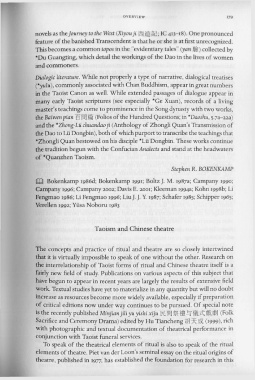Page 219 - The Encyclopedia of Taoism v1_A-L
P. 219
OV E RV I EW 179
novels as the Journey to the West (Xiyouji M Jl!'i:l'ic.; IC 413- 18). One pronounced
feature of the banished Transcendent is that he or she is at first unrecognized.
This becomes a common top os in the "evidentiary tales" (yan ~) collected by
*Du Guangting, which detail the workings of the Dao in the lives of women
and commoners.
Dialogic literature. While not properly a type of narrative, dialogical treatises
(*yulu), commonly associated with Chan Buddhism, appear in great numbers
in the Taoist Canon as well. While extended passages of dialogue appear in
many early Taoist scriptures (see especially *Ge Xuan), records of a living
master's teachings come to prominence in the Song dynasty with two works,
the Baiwen pian S rtl~.m- (Folios of the Hundred Questions; in *Daoshu, 5.7a- 22a)
and the *Zhong-Lu chuandao ji (Anthology of Zhongli Quan's Transmission of
the Dao to Lu Dongbin), both of which purport to transcribe the teachings that
*Zhongli Quan bestowed on his disciple *Lu Dongbin. These works continue
the tradition begun with the Confucian Analects and stand at the headwaters
of *Quanzhen Taoism.
Stephen R. BOKENKAMP
m Bokenkamp 1986d; Bokenkamp 1991; Boltz]. M. 1987a; Campany 1990;
Campany 1996; Campany 2002; Davis E. 2001; Kleeman 1994a; Kohn 1998b; Li
Fengmao 1986; Li Fengmao 1996; Liu].]. Y. 1987; Schafer 1985; Schipper 1965;
Verellen 1992; Yiisa Noboru 1983
Taoism and Chinese theatre
The concepts and practice of ritual and theatre are so closely intertwined
that it is virtually impossible to speak of one without the other. Research on
the interrelationship of Taoist forms of ritual and Chinese theatre itself is a
fairly new field of study. Publications on various aspects of this subject that
have begun to appear in recent years are largely the results of extensive field
work. Textual studies have yet to materialize in any quantity but will no doubt
increase as resources become more widely available, especially if preparation
of critical editions now under way continues to be pursued. Of special note
is the recently published Minjian jili yu yishi xiju ~ fl'l'~:f!.!=j f~ :rt:~J1~ (Folk
Sacrifice and Ceremony Drama) edited by Hu Tiancheng M 7C!VG (1999), rich
with photographic and textual documentation of theatrical performance in
conjunction with Taoist funeral services.
To speak of the theatrical elements of ritual is also to speak of the ritual
elements of theatre. Piet van der Loon's seminal essay on the ritual origins of
theatre, published in 1977, has established the foundation for research in this

